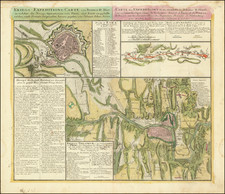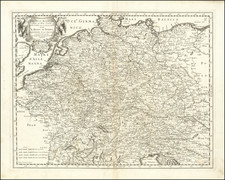Rare early view showing the siege of Neuhausel (Nove Zamky) in June 1621 by the troops of General Charles Bonaventure de Longueval, Comte de Bucquoy.
We note a view with the same title by Georg Keller, listeed in Magyarországi várak és városoknak a M. N. Muzeum könyvtárábán létező fa és rézmetszete. . .(Zsigmond Bubics · 1880), which includes a view of Pressburg.
Depicts siege of Neuhausel, showing armies, artillery, horsemen, tents, roads, bridges, fortifications, surrounding topography, vegetation.
Bucquoy was killed during the siege of Nové Zámky (Érsekújvár/Neuhäusel) on July 10, 1621. One of his commanders, Torquato Conti, attempted to retrieve his body from the battlefield but was captured. Conti was later released and replaced Bucquoy as a commander of Imperial forces.
Nové Zámky/Érsekújvár
The town has a distinguished history. From the second half of the 10th century until 1918, it was part of the Kingdom of Hungary. A fortress was built as a defense against the Ottoman Turks, on the site of an older settlement in the years 1573–81. Between 1589 and 1663, the settlement was the seat of the Captaincy of Lower Hungary. The town developed around the fortress. The huge new fortress was one of the most modern in Europe when it was built, a prime example of the star fortress which was considered to be adapted to the advance in artillery in the preceding centuries. (In fact, the Hungarian name means "the archbishop's new castle".)
The Turks failed to conquer it six times (except Turkish rule between 1566–1595 and 1605–1606), but in 1663 they managed to do so. It was made the center of a Turkish eyalet in present-day southern Slovakia – with the subordinate sanjaks of Litra, Leve, Novigrad, Holok, Bukabak and Şefradi (probably Šahy).









![[ Battle of Prague ] Schlacht bey Praag, in Böhmen, welche den 6. May 1757. von dem Koenig von Preussen, wieder der Kayserlichen Armee, unter Anführung des Prinzen Carls von Lothringen, gewonnen worden.](https://storage.googleapis.com/raremaps/img/small/95536.jpg)


![[ Glatz - 7 Years War ] Des neuen Kriegs Theaters 22. Supplement Plan der Belagerung der Stace und Vestung Glaz...](https://storage.googleapis.com/raremaps/img/small/99034.jpg)
![[ Holy Roman Empire ] A Newe Mape of Germany Newly Augmented by Iohn Speed Ano Dom: 1626](https://storage.googleapis.com/raremaps/img/small/68482.jpg)
![[ Electors of the Holy Roman Empire ] Ordines Sacri Romani Imp: Ab Ottone III Instituti](https://storage.googleapis.com/raremaps/img/small/99053.jpg)